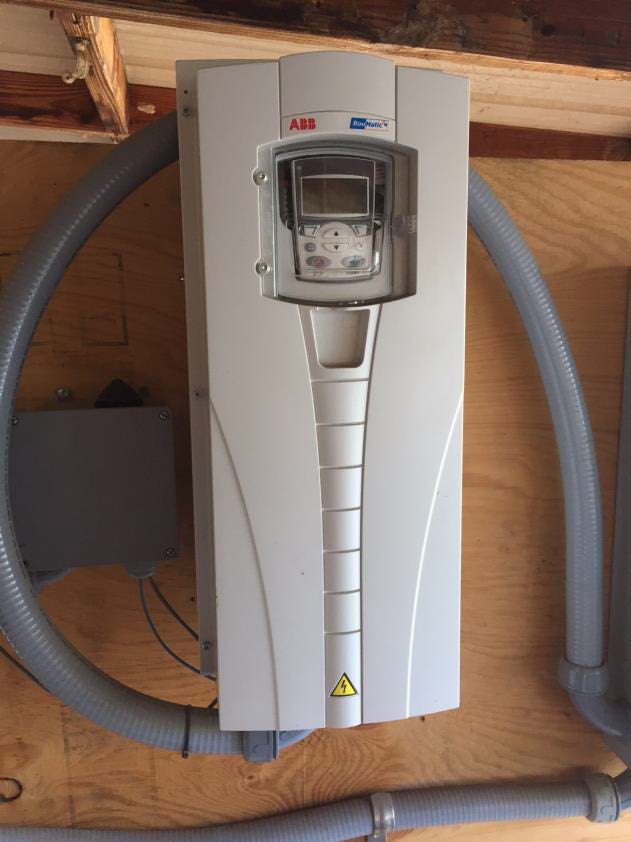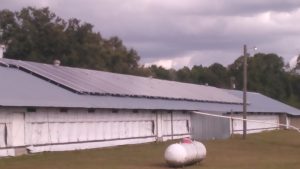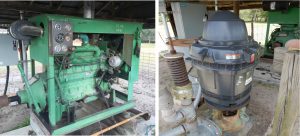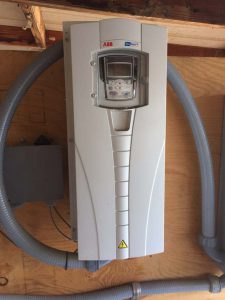
Maximize your farm’s energy savings with FDACS’ free energy evaluations and cost share program

A poultry farm in North Florida used FDACS cost share funds to install solar panels for renewable energy production. Photo source: FDACS Office of Energy
Maximize your farm’s energy savings with FDACS’ free energy evaluations and cost share program
The Florida Department of Agriculture and Consumer Services (FDACS) Office of Energy is currently offering free energy evaluations and cost share funds to increase on-farm energy efficiency to agricultural producers in Florida. This includes all types of operations, such as row crop, fruit and vegetable farms, nurseries, livestock and poultry operations, dairies, and aquaculture farms.
What is an energy evaluation and how is it done?
The purpose of the free evaluations (which are valued at $4,500) is to let producers know how they can maximize energy efficiency and ultimately reduce costs on-farm. During these evaluations, members of a Mobile Energy Lab (MEL) walk through the operation with the producer, evaluating all forms of energy use. Since energy use is often linked to water use (irrigation pivots, for example), the team also assesses water use.
MEL teams are made up of energy experts contracted by FDACS from one of three universities: Florida A&M University, the University of Central Florida and the University of Florida. The MEL will be made up of members from the university closest to the farming operation being evaluated.
After the MEL team has finished the on-site visit, it prepares an evaluation and sends it to the producer. The evaluation details energy use and makes recommendations about how to increase efficiency on-farm. These recommendations depend on the operation and what the farmer is interested in doing. They can include switching to more efficient lighting, converting irrigation pumps from diesel to electric, using variable frequency drives (VFDs) on milk vacuum pumps in dairy operations and switching to or adding small-scale renewable energy generation, like solar or biomass, among others.
After a producer decides on changes she or he would like to make, FDACS offers 80% reimbursement (or cost-share) up to $25,000 to implement recommendations made in the evaluation.
An additional advantage of having a free energy evaluation completed by the MEL is that the evaluation can be used to apply for cost share funds from the USDA-Natural Resources Conservation Service (NRCS) Environmental Quality Incentives Program (EQIP). Producers could potentially receive cost share dollars from both FDACS and NRCS to increase on-farm energy efficiency.

A producer in the Suwanee Valley took advantage of cost share funds to switch from using a diesel irrigation pump (left) to an electric pump (right). Photo source: FDACS Office of Energy
What is the timeframe for applying for energy evaluations and cost share funds?
FDACS offers statewide evaluations and cost share through their FRED Program (Farm Renewable and Efficiency Demonstration). These funds are set to expire September 2018, and so any items or equipment obtained with cost share funds must be purchased and installed by September 2018.
To have enough time to apply for and receive an energy evaluation (which is the first step to obtaining cost share funds), applications for evaluations must be turned in to FDACS by February 1, 2018.
The good news is that a similar program will continue after September. However, it will be in a more geographically restricted area. The Office of Energy received BP RESTORE funds to continue funding energy evaluations and cost share in the Apalachicola and Suwannee River Basins. These funds will be available starting this spring. The office hopes to secure more RESTORE funds in the future to expand the geographic reach of the program.

It’s estimated that dairy farms with 50 cows or more could save 40-55% of milk vacuum pump costs by using a variable frequency drive or variable speed drive (VFD) (shown above) on milk vacuum pumps. Photo source: FDACS Office of Energy
Who is eligible for energy evaluations and cost share funds?
Producers that are eligible for NRCS EQIP funds are eligible for this energy program. As stated by FDACS, this means a producer has to:
- Have control of the land for the term of the proposed contract period.
- Be in compliance with the highly erodible land and wetland conservation provisions described in 7 CFR (Code of Federal Regulations) Part 12.
- Have an interest in the agricultural operation as defined in 7 CFR Part 1400.
- The average adjusted gross income of the individual, joint operation or legal entity, may not exceed $900,000
If you have any questions about these requirements, please contact Takara Waller at the Office of Energy (contact information listed below).
How do you apply for an energy evaluation?
To apply for an energy evaluation, you need to submit an application to the FDACS Office of Energy. Application forms and instructions on how to submit them, as well as more information about the program can be found at http://www.freshfromflorida.com/Business-Services/Energy/Incentives-for-Agriculture-Producers
If you have any questions, Takara Waller from the Office of Energy can help guide you through the process. Her contact information is:
(850) 617-7470 (phone)
(850) 617- 7471 (fax)
Takara.Waller@FreshFromFlorida.com
For more information about NRCS EQIP cost share funds, contact your local NRCS office. Contact information for offices in the panhandle region can be found at https://www.nrcs.usda.gov/wps/portal/nrcs/detail/fl/contact/local/?cid=nrcs141p2_015022
Your local USDA Farm Services Agency can also provide more information about cost share programs related to energy. Contact information by county is found by selecting (or clicking on) the county of interest on the following map https://offices.sc.egov.usda.gov/locator/app?service=page/CountyMap&state=FL&stateName=Florida&stateCode=12.
Remember: an energy evaluation is the first step in obtaining cost share funds to increase on-farm energy efficiency and savings.
